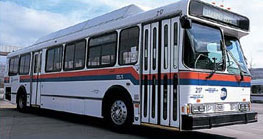|
Is it bye-bye, Long Island Bus?
by Laura Schofer
Originally published in the 2011 March 10 edition of The
Wantagh-Seaford Citizen.
Published online with kind permission from our friends at The Citizen.
The Metropolitan Transportation Authority (MTA) plans to cut 25 of its 48
Long Island Bus routes in Nassau County, including the N73 and N74, which
provide corridor service along Jerusalem Avenue in Hicksville and Wantagh
Avenue in North Wantagh and Wantagh. The N73 and N74 also provide branch
services along Hempstead Turnpike to west Levittown (along to Schoolhouse
Road and Hickory Lane before returning to Jerusalem Avenue). There are no
alternatives for individuals using public transportation.
|

Proposed MTA cuts include Wantagh routes N73 and N74
|
The MTA announced the planned cuts as part of its February Financial Plan
for 2011-2014. The cuts will effect 16,000 out of 100,000 daily bus riders,
including 18% of Able-Ride users, reads the MTA proposal. The proposal also
eliminates 200 LI bus employees.
Why eliminate these routes? Money. In its proposal, the MTA stated that it
can no longer afford to subsidize Long Island Bus. The MTA and Nassau County
have an agreement to provide bus services to residents. Since 2000, the MTA
had agreed to help subsidize Long Island Bus in order to bridge budget gaps
but the county has not increased its contribution. The county pays $9.1
million for bus service. It is the only suburban county that has subsidized
bus service. Both Suffolk County and Westchester County have private bus
service, which costs the counties $20 and $30 million respectively.
“This year Nassau County’s funding will fall $24 million short of what is
needed to operate the current local bus and Able-Ride network,” states the
MTA proposal. “While in the past MTA filled funding gaps caused by Nassau
County’s underfunding – contributing over $140 million since 2000 – today,
given the MTA’s fragile fiscal condition, we can no longer afford to do so.”
“This is devastating,” said Ryan Lynch Long Island coordinator of the
Tri-State Transportation Campaign, a watchdog group that studies public
transportation. “Long Island Bus helps to support businesses and gets people
to and from work. It also helps to eliminate some congestion on our roads.
What alternatives will people have?”
“Many of our residents depend upon bus transportation to conduct their daily
routine. Bus transportation is the only choice they have,” stated county
Legislator Kevan Abrahams.
The MTA does acknowledge the difficulty, stating “The MTA recognizes that
these service reductions would be extremely difficult for thousands of
people who work and live in Nassau County and depend on the local bus and
Able-Ride Networks – many of whom have no alternatives.”
“The MTA is acting rashly in eliminating these routes overnight,” said Mr.
Lynch, but added that “Nassau County is also at fault. The county has
refused [to date] to increase its contribution to LI Bus even though it is
the only suburban county to receive MTA funding for its bus system.”
“The MTA has had no problem cutting its expenses at the expense of Nassau
County residents,” said Brian Nevin, communications director for County
Executive Edward Mangano. “The MTA forgets that Nassau County residents pay
$10 million a year in MTA payroll tax and they don’t credit us a dime. All
that money goes to subsidize New York City transit,” he said.
|
 |
MTA plans to eliminate service for our disabled and
most vulnerable residents. |
 |
|
Edward Mangano
Nassau County Executive |
|
Mr. Nevin said the county has been in negotiations with the MTA and has
offered to increase its share. “We have made a good faith effort but the MTA
has been unresponsive. They want an additional $26 million and we can’t do
that in a single year, not with the kind of budget crunch that Nassau County
is facing,” he said. “They need to make cuts and that’s the bottom line.”
“It’s shameful that the MTA plans to eliminate service for our disabled and
most vulnerable residents,” said County Executive Mangano in a prepared
statement. When the county executive learned about the proposal late last
year, the county issued a request for proposals “for a public/private
partnership with a bus operator. Three operators responded,” said Mr. Nevin.
“When we learned the MTA plans on cutting 56% of its routes, we went back to
these companies and asked them how they could provide better service. They
have until March 23 to respond,” said Mr. Nevin.
But Mr. Lynch believes “privatization is not a viable plan. Our position is
that the MTA and the county must work together and put the riders first,”
said Mr. Lynch. “You need to find a balanced approach so that everyone
benefits.”
Mr. Lynch urges residents to contact state Senator Charles Fuschillo,
chairman of the Senate Transportation Committee, as well as Governor Cuomo’s
office to resolve the matter.
Additionally, a public hearing regarding the elimination of the Long Island
bus routes will take place on Wednesday, March 23, at 3 p.m. at Hofstra
University’s Adams Playhouse. Residents are encouraged to attend.
|